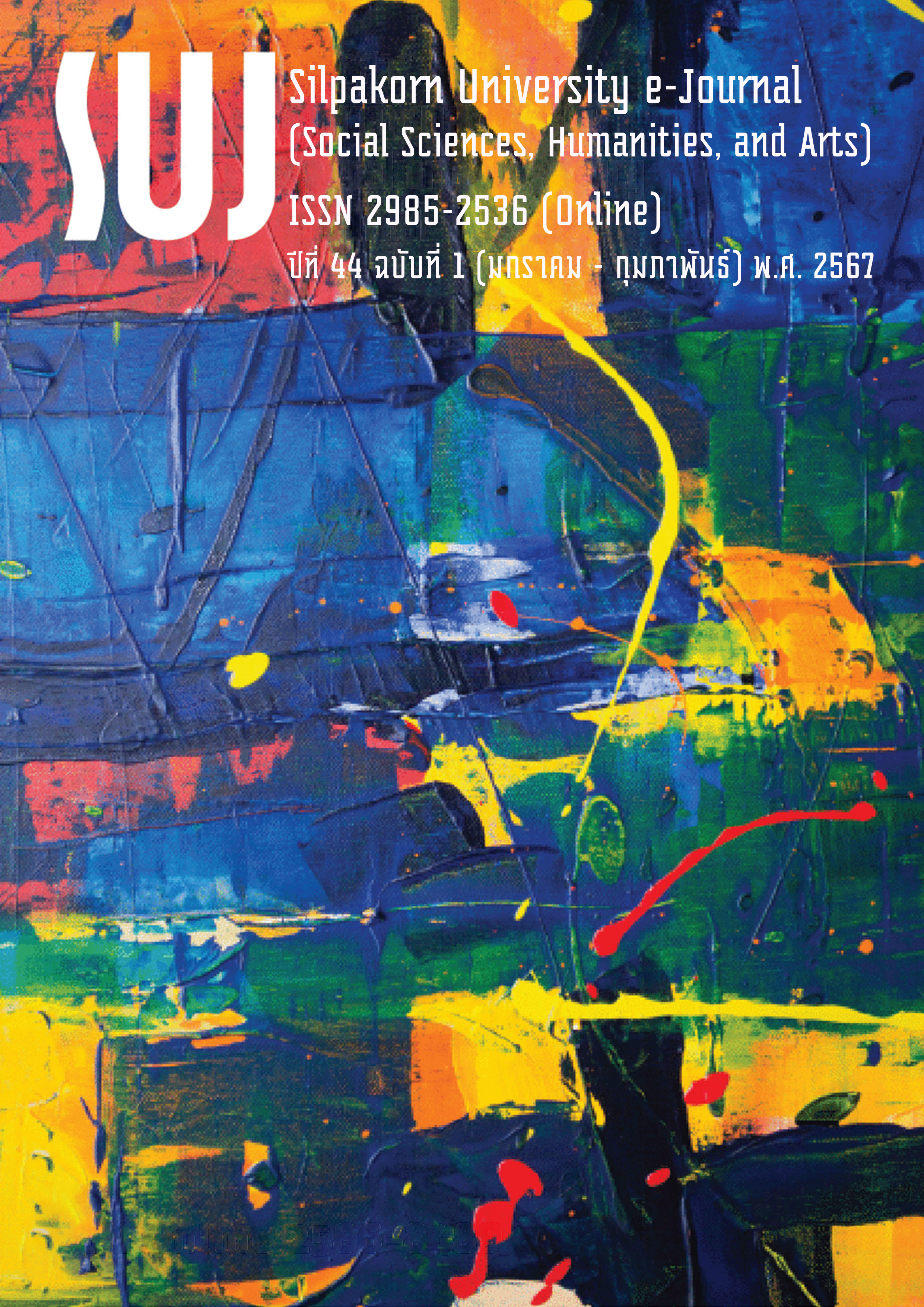ทฤษฎีฐานรากเพื่อเอกลักษณ์การออกแบบเครื่องประดับไทยร่วมสมัย (Grounded theory for the identity of contemporary jewellery design in Thailand)
Main Article Content
Abstract
บทความวิจัย เรื่อง ทฤษฎีฐานรากเพื่อเอกลักษณ์การออกแบบเครื่องประดับไทยร่วมสมัย มีวัตถุประสงค์เพื่อแสวงหาทฤษฎีฐานรากอันเป็นความรู้ที่ฝังลึกบนพื้นฐานของวิชาการด้านสุนทรียศาสตร์แก่วงการอัญมณีและเครื่องประดับ พร้อมสนับสนุนโอกาสในการสร้างประสิทธิภาพเชิงวิเคราะห์ โดยวิธีดำเนินการวิจัยมุ่งเน้นความเจริญก้าวหน้าด้านการสร้างสรรค์เครื่องประดับไทยแต่ละยุคสมัย และจัดหมวดหมู่ของปรากฏการณ์แห่งมูลเหตุออกเป็น 2 ช่วงเวลา ได้แก่ ก้าวสู่ความทันสมัย และสมัยใหม่สมัยน่านิยม ซึ่งตัวแปรแห่งการเปลี่ยนแปลงในแต่ละช่วงเวลา จะถูกพิจารณาด้วยสาระสำคัญของหลักการออกแบบ เนื่องจากประโยชน์ใช้สอยของเครื่องประดับแต่ละยุคสมัยเปรียบได้ดังเครื่องมือสื่อสารที่สร้างเสริมความสัมพันธ์ระหว่างมนุษย์ ทั้งนี้ คุณค่าของเครื่องประดับเอื้อให้เกิดการยกระดับสติปัญญาและจิตใจของผู้คนในสังคม โดยเฉพาะอย่างยิ่ง รูปแบบของเครื่องประดับยุคปัจจุบันที่ได้รับอิทธิพลจากปรัชญาศิลปะร่วมสมัย มักแสดงทัศนคติที่ก้าวหน้า มีความขบถต่อโครงสร้าง และท้าทายแบบแผนการสร้างสรรค์อันถือเป็นประเพณีนิยมของผลงานทัศนศิลป์ สิ่งเหล่านี้ส่งเสริมให้ศิลปินหรือนักออกแบบเครื่องประดับรุ่นใหม่มีอิสรภาพในการแสดงออกถึงความคิด วัสดุ และเทคโนโลยีการผลิต ทั้งหมดล้วนส่งผลให้ผลงานการออกแบบเครื่องประดับไทยสะท้อนสภาวการณ์ของสังคมร่วมสมัยอย่างทันท่วงที ดังนั้น การเผยแพร่ผลสรุปของทฤษฎีฐานรากสำหรับการออกแบบเครื่องประดับไทยร่วมสมัย จึงมีองค์ประกอบ 2 ส่วน คือ การออกแบบรูปลักษณ์ และประโยชน์ใช้สอย ทั้งสองเป็นสิ่งจำเป็นสำหรับวิชาการออกแบบ และด้วยประจักษ์ได้ว่า ภาพลักษณ์แห่งยุคสมัยส่งต่อความรู้ชัดแจ้ง เป็นส่วนสำคัญต่อพัฒนาการด้านการออกแบบ สุนทรียภาพในการดำรงชีวิต ตลอดจนการสร้างเอกลักษณ์ของชนชาติผ่านผลงานเครื่องประดับไทยร่วมสมัยในฐานะวัตถุบ่งชี้อารยธรรม
This research aims to uncover the grounded theory embedded in aesthetics within the jewellery and gemstone industry. It will serve as a foundation for a comprehensive analysis, using a research method that explores the evolution of the interpretation and creation in Thai contemporary jewellery over time. The research timeframe is divided into two distinct periods: the shift to modernity and the enchanting modern Thai era. Change factors in each period are analyzed against the backdrop of contemporary design principles. Jewellery in each era serves as a communication tool, fostering relationships and uplifting individuals intellectually and aesthetically. Contemporary jewellery designs, influenced by contemporary art philosophy, often express progressive ideas, challenge established structures, and break from traditional creative patterns. These changes empower avant-garde artists and designers to freely express conceptual ideas, materials, and production technology, resulting in immediate reflections of society. All these factors contribute to the timely reflection of Thai contemporary jewellery design on the current social situation. The summary of the grounded theory for Thai contemporary jewellery design consists of two essential components: aesthetic design and functional utility, both crucial for design study. It is evident that the image of each era conveys knowledge, a significant part of the development of design aesthetics in life, as well as the creation of national identity through Thai contemporary jewellery as evidence of civilization.
Downloads
Article Details

This work is licensed under a Creative Commons Attribution-NonCommercial-NoDerivatives 4.0 International License.
References
Art and Culture Editorial Board. (1997). Fashion in the royal court when Siam embraced westernization: 100 years of modernization (แฟชั่นราชสำนัก เมื่อสยามแต่งฝรั่ง 100 ปี Modernization). Art and Culture, 18(10): 76-86.
Art and Culture Editorial Board. (2017). April 21, B.E. 2325: King Rama I Ordered the City Pillar Laying Ceremony (21 เมษายน พุทธศักราช 2325 : รัชกาลที่ 1 โปรดเกล้าฯ ให้ทำพิธีวางเสาหลักเมือง). [Online]. Retrieved February 28, 2022 from https://www.silpa-mag.com/this-day-in-history/article_8473
Art and Culture Editorial Board. (2019). King Rama IV’s Proclamation on the Proper Use of “Wearing” (รัชกาลที่ 4 ออกประกาศ ควรใช้คำว่า “ใส่” ให้ถูกต้อง). [Online]. Retrieved August 9, 2023 from https://www.silpa-mag.com/culture/article_35837
Danto, A. C. (1989). Connections to the World: The Basic Concepts of Philosophy. NY: Harper and Row.
Department of Industrial Promotion, Ministry of Industry. (2007). Article: Rattanakosin Goldware (บทความ: เครื่องทองรัตนโกสินทร์). [Online]. Retrieved February 28, 2022 from https://www.ryt9.com/s/ryt9/114485
Duke, Pensri. (1999). Foreign Affairs and Thailand’s Independence and Sovereignty: From the Reign of King Rama IV to the End of Field Marshal P. Phibunsongkhram’s Era (การต่างประเทศกับเอกราชและอธิปไตยของไทย (ตั้งแต่สมัยรัชกาลที่ 4 ถึงสิ้นสมัยจอมพล ป. พิบูลสงคราม)). Bangkok: Tex and Journal Publication.
Gersh-Nesic, B. (2019). Origins and Schools of Abstract Art: Art Without a Subject. [Online]. Retrieved March 9, 2022 from https://www.thoughtco.com/what-is-abstract-art-183186
Kasetsiri, Charnvit, La-ongsri, Kanchanee, Puaksom, Chanida, Ruangsilp, Bhawan, Nibhatsukit, Warangkana, Jansaeng, Apiradee, Sriudom, Kanthika, Povatong, Pirasri, Vilaithong, Villa, Jewachinda Meyer, Morakot, & Chanamun Cole, Sopha (Trans.). (2013). Thailand: A Short History (ประวัติศาสตร์ไทยฉบับสังเขป). Bangkok: The Foundation for The Promotion of Social Science and Humanities Textbooks Project.
Kurowat, Puangpaka. (1997). Costume History Guide, Revised and Additional Edition (คู่มือประวัติเครื่องแต่งกาย ฉบับปรับปรุงแก้ไขและเพิ่มเติม) (5th ed.). Bangkok: Ruamsarn.
Lacayo, R. (2007). The Sunshine Boy: A Vast New Show Illuminates J.M.W. Turner, The Man Who Took British Painting into the Light. Time Magazine. [Online]. Retrieved March 7, 2022 from http://content.time.com/time/subscriber/article/0,33009,1670528,00.html
McQuail, L. (1997). Treasures of Two Nations: Thai Royal Gifts to the United States of America. Washington, DC: Asian Cultural History Program, Smithsonian Institution.
Meylan, V. (2014). Van Cleef & Arpels: Treasures and Legends. Suffolk: Antique Collectors’ Club.
Nawikmun, Anek. (2004). Dress in Rattanakosin Period (การแต่งกายสมัยรัตนโกสินทร์) (2nd ed.). Bangkok: Muang Boran Press.
Office of the Royal Secretariat. (1982). Photobook of Important Events of Rattanakosin (สมุดภาพเหตุการณ์สำคัญของกรุงรัตนโกสินทร์). Bangkok: Bangkok Printing House.
Parsons, G. (2008). Aesthetics and Nature. London: Continuum International Publishing Group. [Online]. Retrieved March 10, 2022 from https://www.perlego.com/book/805552/aesthetics-and-nature-pdf
Royal Chronicles, Volume of Royal Ordinances (พระราชพงศาวดารฉบับพระราชหัตถเลขา). (1999). Bangkok: Division of Literature and History, The Fine Arts Department.
Rueangsil, Chai. (1998). Thai History During 1809-1910: Economic Aspects (ประวัติศาสตร์ไทยสมัย พ.ศ. 2352-2453: ด้านเศรษฐกิจ) (3rd ed.). Bangkok: Thai Watanapanich Printing House.
Sriworapoj, Boontuen, & Phosrithong, Prapassorn (Eds.). (1999). Rattanakosin Goldware (เครื่องทองรัตนโกสินทร์). Bangkok: Starprint.
Thai Costume Committee, The National Identity Office. (2000). Thai Costume: Evolution from the Past to the Present (Vol. 1-2) (การแต่งกายไทย: วิวัฒนาการจากอดีตสู่ปัจจุบัน 1-2). Bangkok: Amarin Printing and Publishing.
Thai Historical Archives. (2020). Thai Historical Archieves (คลังประวัติศาสตร์ไทย) [Facebook page]. Facebook. Retrieved March 10, 2022 from https://www.facebook.com/ThailandHistoricalArchives/
The Fine Arts Department, Ministry of Culture. (1968). Meeting to Announce the Reign of King Rama IV B.E. 2405-2411 (ประชุมประกาศ รัชกาลที่ 4 พ.ศ. 2405-2411). Phra Nakhon: Rien Thong Printing.
The Fine Arts Department, Ministry of Culture. (1992). Thanimphimpaporn (ถนิมพิมพาภรณ์). Bangkok: Office of National Museums.
The Golden Jubilee Network. (n.d.). Royal History His Majesty King Bhumibol Adulyadej (พระราชประวัติ พระบาทสมเด็จพระปรมินทรมหาภูมิพลอดุลเดช มหิตลาธิเบศรรามาธิบดี จักรีนฤบดินทร สยามินทราธิราช บรมนาถบพิตร). [Online]. Retrieved March 10, 2022 from https://ka.mahidol.ac.th/king_9/history.html
Thuillier, J. (2004). History of Art. Paris: Flammarion.
Vespada, Yaowanuch, Khumraksa, Sirisak, & Soksawasmekin, Patcharee. (2005). Masterpieces of Thai Exquisite Crafts: Cultural Heritage of Siam (ประณีตศิลป์: มรดกแผ่นดินแห่งสยามประเทศ). Bangkok: V. Print (1991).
Yin, R. K. (1994). Applications of Case Study Research. Thousand Oaks, CA: SAGE.


